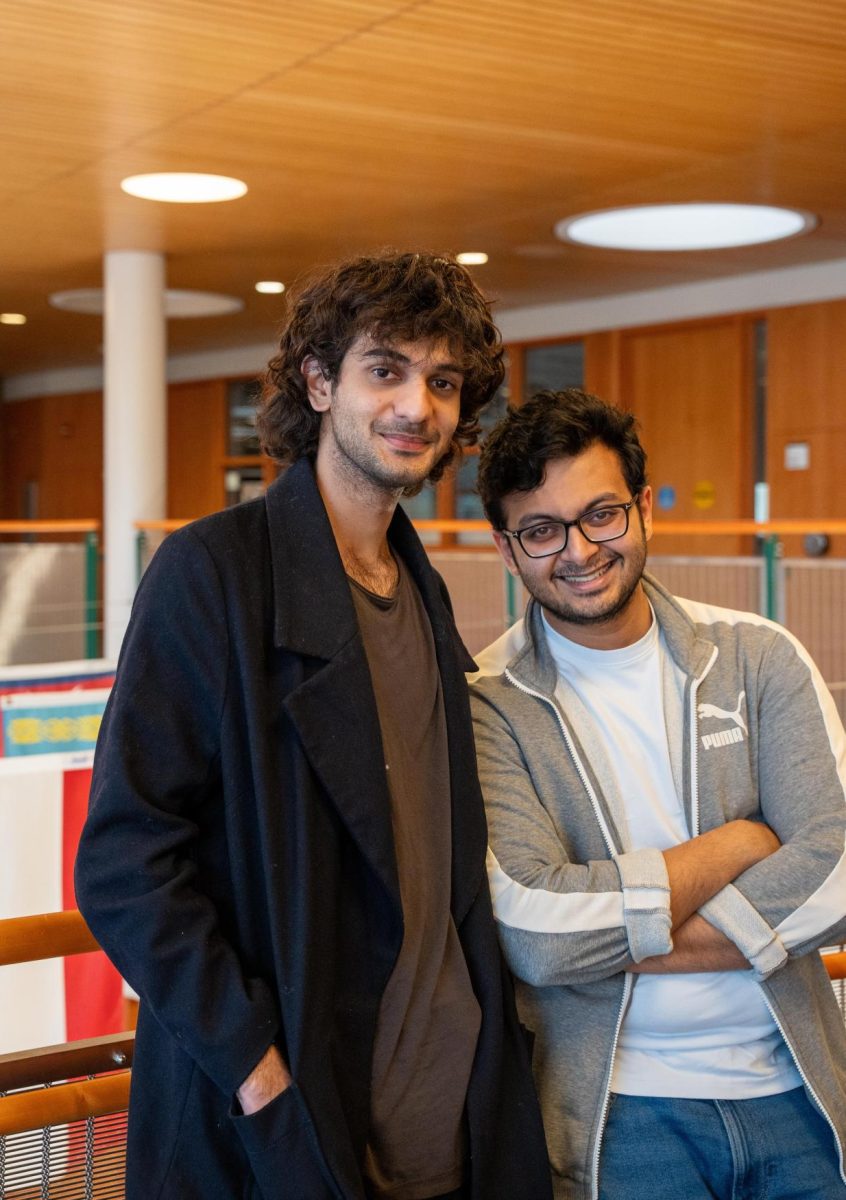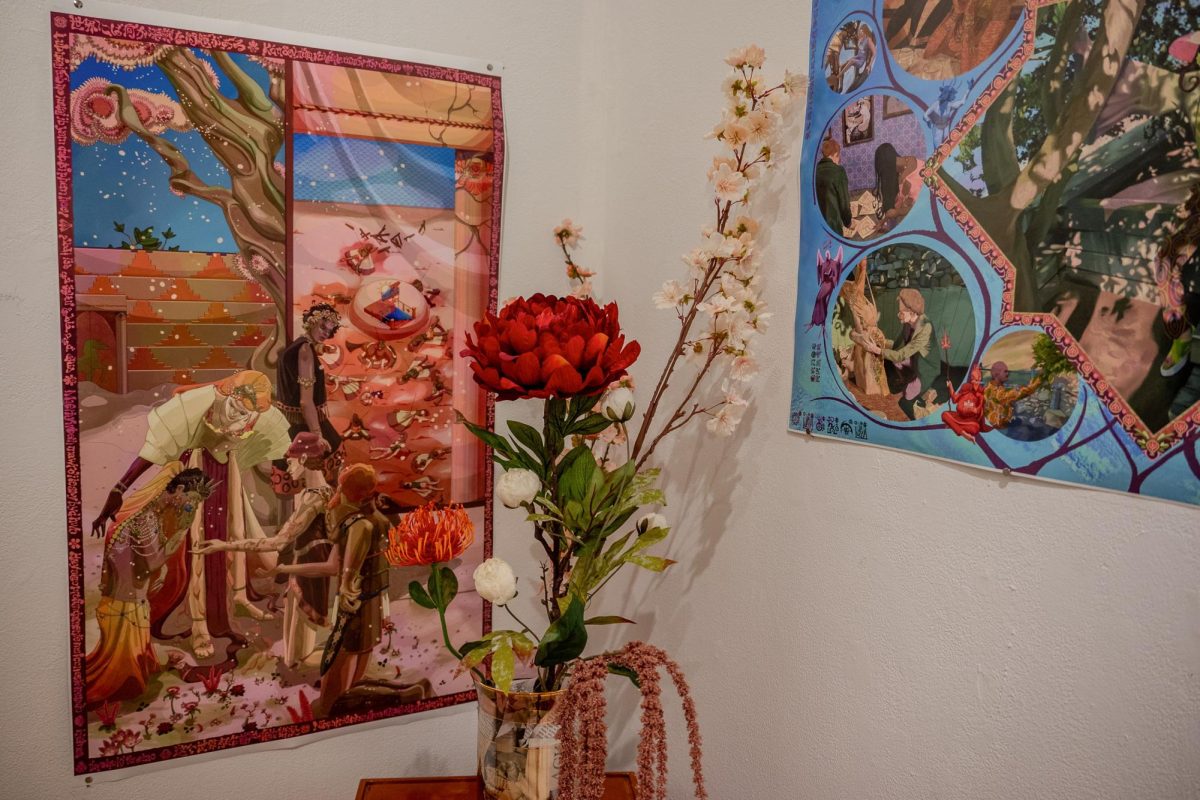The Grinnell College Museum of Art (GCMoA) invites members of the Grinnell community to enter a conversation with a new exhibition, “William Villalongo: Myths and Migrations.” Daniel Strong, museum associate director and curator of exhibitions, hosted the exhibit’s opening reception on Thursday, Jan. 25.
Brooklyn-based artist William Villalongo said that the works in the collection, which comprises more than 30 paintings, collages and signature velour paper cut-outs, “become portals or navigational devices for thinking about the mystery within human experience through the poetics of history, myth and satire.”
According to Villalongo, the exhibition critically examines the Western conventions of art. “There’s a very specific place where you start to see Black artists find themselves in the conversation — but in the larger trajectory of Western art, Black lives, ideas and concerns are not at the forefront of the discussion,” he said. “Our bodies and our labor certainly have been behind all of it, underneath all of it.”
Mae Adhikari `26, who attended the opening reception, said, “It’s amazing that the College has access to, essentially, a time capsule of Villalongo’s journey. Particularly his most recent pieces are cool and refreshing to see.”
Timothy S. Dobe, professor and department chair of religious studies, said he took particular interest in “Specimen,” which is crafted with stenciled linen pulp paint, black abaca, and collaged inkjet prints against a black cotton base sheet. Dobe described “Specimen” as an “exchange of seeing.”
He said, “There are more subjects than I’m used to seeing in a gallery. I’m usually more seeing the art itself, while I feel like these pieces are much more ready to see me.”
Villalongo said his work fits somewhere “in between triumph and resistance.” He said that the intention behind the black backdrop in “Specimen” emerged from questions he asked himself throughout his art education. He said he finds the regal in what society considers to be “kitschy” or “in distaste,” especially on his signature black velvet prints.
“All of my searching as a student led me to realize that the tools that I had available to me were coming out of the same sort of systems that were rendering me invisible, and I began to question that even down to the material,” said Villalongo.
However, Villalongo said that his work does not evoke questions of technical virtuosity, but rather lies in the content and the context from which they emerge.
Jonathan Larson, assistant professor of education, said he enjoyed Villalongo’s historical narration of the Haitian revolutionary figure Jean-Baptiste Belley, a formerly enslaved man who rose to prominence as a leader in the Haitian Revolution, in “Obertura de la Espora (Time Dancer).”
In one of the centerpieces of the exhibition, “Mothership Connection,” Larson said he appreciated, “the language of the artist being deliberate about commenting on both a longer point in African American history, like referencing the slave ship and other African masks while also incorporating Afrofuturism, and evoking the iconic figure, George Clinton.”

Villalongo said that some of the pieces are “problematic,” in the sense that they elicit discussion and implicate himself as the artist and as a Black man.
An anonymous community member said about the presence of Black women in the artist’s works, “In some ways you can look at it and take what you want from it, but on the other hand, when you’re reading, there’s this ‘Aha’ moment, and you see what he’s trying to do, which is much more complicated.” They said, “you really need to look at it, then read about it, then look at it again.”
Cadence Chen `26 said, “There will always be that disconnect between yourself and people that are different from you. For Villalongo to engage with an all-female cast, he is saying you can step into different shoes. The question is how you make it seem like you’re not just experimenting with other people’s bodies, and in his work, women’s bodies.”
In reference to Villalongo’s “Rhombus,” Chen said that Grinnell is the perfect place for conversations surrounding representation in art, particularly in holding multiple narratives and disrupting single stories.
Villalongo said he believes that in his work, there lies a “kind of lived experience in an attempt to kind of find a balance between those sorts of contradictory things or contrast, and things like pain and beauty and struggle and liberation.”
Strong said he hopes the Museum will have a permanent collection upon expansion. For now, he is satisfied with the artists the College features.
“Myths and Migrations” runs from Jan. 25 to March 31. Villalongo will visit Grinnell College to hold a public gallery talk on Wednesday, Feb. 7 at 4 p.m.






















































